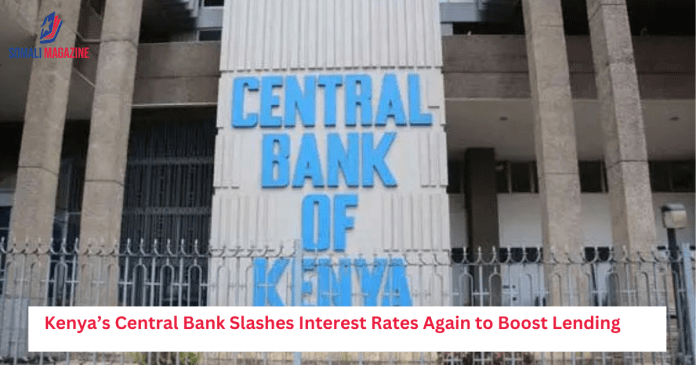Facebook Twitter (X) Instagram Somali Magazine - People's Magazine
In a surprise move, CBK cuts benchmark rate to 10% and eases borrowing rules to stimulate private sector growth and economic recovery
In a move that caught many experts off guard, Kenya’s central bank lowered its main interest rate once again—this being the fifth time in a row. The decision is aimed at encouraging more lending by banks to businesses and individuals, which could help boost the country’s economic activity.
The Central Bank of Kenya (CBK) reduced the Central Bank Rate (CBR) by 75 basis points, bringing it down to 10.0%. This was unexpected by most analysts. Out of nine economists recently surveyed by Reuters, seven had predicted that the rate would stay the same. Only two thought it might be cut.
In a statement released after its latest Monetary Policy Committee (MPC) meeting, the bank said, “The Committee concluded that there was room to further ease monetary policy in order to encourage banks to lend more to the private sector and support overall economic growth.”
The bank made a few more changes alongside the rate cut, all meant to improve how interest rates are managed in the country. One of those changes was narrowing the interest rate corridor around the CBR. Previously, the corridor allowed a wider range of movement (plus or minus 150 basis points), but now it’s been tightened to plus or minus 75 basis points. This means interest rates are likely to stay closer to the central bank’s benchmark rate, which helps stabilize borrowing costs between banks.
In simple terms, this move will help make the cost of short-term borrowing between banks more stable and predictable. That stability should trickle down to businesses and consumers through better access to affordable credit.
Another notable adjustment the CBK made was to the discount window rate. This is the rate at which commercial banks can borrow from the central bank for short-term needs, often overnight. Previously, banks had to pay 3.0% more than the CBR to access these funds. Now, they’ll only pay 0.75% more. This makes it cheaper for banks to borrow from the CBK, which again could make it easier for them to lend to the public.
This wave of policy changes comes at a time when Kenya’s inflation rate is relatively low and stable. The country’s annual inflation stood at 3.6% in March, a slight rise from 3.5% in February, but still comfortably within the target range of 2.5% to 7.5% set by the central bank. With inflation not posing a serious threat, the bank had more flexibility to cut interest rates to help the economy grow.
Despite the lower interest rates, the central bank remains confident about the country’s economic outlook. It kept its forecast for Kenya’s economic growth in 2025 at 5.4%, an improvement from last year’s estimated growth of 4.6%. That means the economy is expected to pick up speed.
The bank also updated its projection for Kenya’s current account deficit, which is a measure of the country’s trade balance and financial flows. It now expects a deficit of 2.8% of GDP in 2025—an improvement compared to its earlier forecast in February, which was 3.8%.
To sum it up, Kenya’s central bank is taking bold steps to support the economy. By making it cheaper for banks to borrow and lend, it hopes to encourage more investment and spending. And with inflation low and the economy showing signs of recovery, the CBK believes now is the right time to act.
These changes are part of a broader effort to maintain financial stability while helping the economy grow faster in the years ahead.

